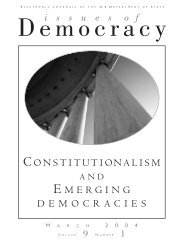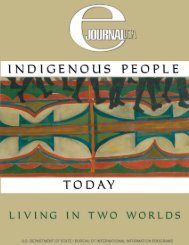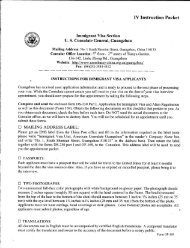s. history us history us history - Embassy of the United States
s. history us history us history - Embassy of the United States
s. history us history us history - Embassy of the United States
- No tags were found...
Create successful ePaper yourself
Turn your PDF publications into a flip-book with our unique Google optimized e-Paper software.
CHAPTER 5: WESTWARD EXPANSION AND REGIONAL DIFFERENCESOUTLINE OF U.S. HISTORYfined in wretched almsho<strong>us</strong>es andprisons. After winning improvementsin Massach<strong>us</strong>etts, she tookher campaign to <strong>the</strong> South, wherenine states established hospitals for<strong>the</strong> insane between 1845 and 1852.WOMEN’S RIGHTSSuch social reforms brought manywomen to a realization <strong>of</strong> <strong>the</strong>ir ownunequal position in society. Fromcolonial times, unmarried womenhad enjoyed many <strong>of</strong> <strong>the</strong> same legalrights as men, although c<strong>us</strong>tom requiredthat <strong>the</strong>y marry early. Withmatrimony, women virtually lost<strong>the</strong>ir separate identities in <strong>the</strong> eyes<strong>of</strong> <strong>the</strong> law. Women were not permittedto vote. Their education in <strong>the</strong>17th and 18th centuries was limitedlargely to reading, writing, m<strong>us</strong>ic,dancing, and needlework.The awakening <strong>of</strong> women beganwith <strong>the</strong> visit to America <strong>of</strong> FrancesWright, a Scottish lecturer and journalist,who publicly promoted women’srights throughout <strong>the</strong> <strong>United</strong><strong>States</strong> during <strong>the</strong> 1820s. At a timewhen women were <strong>of</strong>ten forbiddento speak in public places, Wright notonly spoke out, but shocked audiencesby her views advocating <strong>the</strong>rights <strong>of</strong> women to seek informationon birth control and divorce. By <strong>the</strong>1840s an American women’s rightsmovement emerged. Its foremostleader was Elizabeth Cady Stanton.In 1848 Cady Stanton and hercolleague Lucretia Mott organizeda women’s rights convention — <strong>the</strong>first in <strong>the</strong> <strong>history</strong> <strong>of</strong> <strong>the</strong> world — atSeneca Falls, New York. Delegatesdrew up a “Declaration <strong>of</strong> Sentiments,”demanding equality withmen before <strong>the</strong> law, <strong>the</strong> right to vote,and equal opportunities in educationand employment. The resolutionspassed unanimo<strong>us</strong>ly with <strong>the</strong>exception <strong>of</strong> <strong>the</strong> one for women’ssuffrage, which won a majority onlyafter an impassioned speech in favorby Frederick Douglass, <strong>the</strong> blackabolitionist.At Seneca Falls, Cady Stantongained national prominence as aneloquent writer and speaker forwomen’s rights. She had realizedearly on that without <strong>the</strong> right tovote, women would never be equalwith men. Taking <strong>the</strong> abolitionistWilliam Lloyd Garrison as her model,she saw that <strong>the</strong> key to success layin changing public opinion, and notin party action. Seneca Falls became<strong>the</strong> catalyst for future change. Soono<strong>the</strong>r women’s rights conventionswere held, and o<strong>the</strong>r women wouldcome to <strong>the</strong> forefront <strong>of</strong> <strong>the</strong> movementfor <strong>the</strong>ir political and socialequality.In 1848 also, Ernestine Rose, aPolish immigrant, was instrumentalin getting a law passed in <strong>the</strong> state<strong>of</strong> New York that allowed marriedwomen to keep <strong>the</strong>ir property in<strong>the</strong>ir own name. Among <strong>the</strong> firstlaws in <strong>the</strong> nation <strong>of</strong> this kind, <strong>the</strong>Married Women’s Property Act encouragedo<strong>the</strong>r state legislatures toenact similar laws.In 1869 Elizabeth Cady Stantonand ano<strong>the</strong>r leading women’s rightsactivist, S<strong>us</strong>an B. Anthony, founded<strong>the</strong> National Woman Suffrage Association(NWSA), to promote a constitutionalamendment for women’sright to <strong>the</strong> vote. These two wouldbecome <strong>the</strong> women’s movement’smost outspoken advocates. Describing<strong>the</strong>ir partnership, Cady Stantonwould say, “I forged <strong>the</strong> thunderboltsand she fired <strong>the</strong>m.”WESTWARDThe frontier did much to shapeAmerican life. Conditions along<strong>the</strong> entire Atlantic seaboard stimulatedmigration to <strong>the</strong> newer regions.From New England, where <strong>the</strong> soilwas incapable <strong>of</strong> producing highyields <strong>of</strong> grain, came a steady stream<strong>of</strong> men and women who left <strong>the</strong>ircoastal farms and villages to takeadvantage <strong>of</strong> <strong>the</strong> rich interior land<strong>of</strong> <strong>the</strong> continent. In <strong>the</strong> backcountrysettlements <strong>of</strong> <strong>the</strong> Carolinas andVirginia, people handicapped by <strong>the</strong>lack <strong>of</strong> roads and canals giving accessto coastal markets and resentful<strong>of</strong> <strong>the</strong> political dominance <strong>of</strong> <strong>the</strong>Tidewater planters also moved westward.By 1800 <strong>the</strong> Mississippi andOhio River valleys were becoming agreat frontier region. “Hi-o, away wego, floating down <strong>the</strong> river on <strong>the</strong> O-hi-o,” became <strong>the</strong> song <strong>of</strong> tho<strong>us</strong>ands<strong>of</strong> migrants.The westward flow <strong>of</strong> populationin <strong>the</strong> early 19th century led to <strong>the</strong>division <strong>of</strong> old territories and <strong>the</strong>drawing <strong>of</strong> new boundaries. As newstates were admitted, <strong>the</strong> politicalmap stabilized east <strong>of</strong> <strong>the</strong> MississippiRiver. From 1816 to 1821, six stateswere created — Indiana, Illinois,and Maine (which were free states),and Mississippi, Alabama, and Missouri(slave states). The first frontierhad been tied closely to Europe, <strong>the</strong>second to <strong>the</strong> coastal settlements,but <strong>the</strong> Mississippi Valley was independentand its people looked westra<strong>the</strong>r than east.Frontier settlers were a variedgroup. One English traveler described<strong>the</strong>m as “a daring, hardyrace <strong>of</strong> men, who live in miserablecabins. ... They are unpolished buthospitable, kind to strangers, honest,and tr<strong>us</strong>tworthy. They raise alittle Indian corn, pumpkins, hogs,and sometimes have a cow or two.... But <strong>the</strong> rifle is <strong>the</strong>ir principalmeans <strong>of</strong> support.” Dextero<strong>us</strong> with<strong>the</strong> ax, snare, and fishing line, <strong>the</strong>semen blazed <strong>the</strong> trails, built <strong>the</strong> firstlog cabins, and confronted NativeAmerican tribes, whose land <strong>the</strong>yoccupied.As more and more settlers penetrated<strong>the</strong> wilderness, many becamefarmers as well as hunters. A comfortablelog ho<strong>us</strong>e with glass windows,a chimney, and partitionedrooms replaced <strong>the</strong> cabin; <strong>the</strong> wellreplaced <strong>the</strong> spring. Ind<strong>us</strong>trio<strong>us</strong>settlers would rapidly clear <strong>the</strong>irland <strong>of</strong> timber, burning <strong>the</strong> woodfor potash and letting <strong>the</strong> stumpsdecay. They grew <strong>the</strong>ir own grain,vegetables, and fruit; ranged <strong>the</strong>woods for deer, wild turkeys, andhoney; fished <strong>the</strong> nearby streams;looked after cattle and hogs. Landspeculators bought large tracts <strong>of</strong> <strong>the</strong>cheap land and, if land values rose,122123












